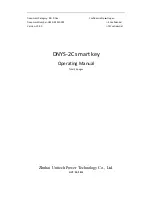
1
G007818
Figure 24
1.
Rear tie-down loops
Lifting the Machine
You can lift the machine using the tie-down/lift loops
as lift points (Figure 23 and Figure 24).
Operating Tips
•
Clean the area of trash, branches and rocks before
trenching to prevent equipment damage.
•
Always begin trenching with the slowest ground
speed possible. Increase speed if conditions permit.
If the chain speed slows down, reduce ground speed
to keep the chain moving at its fastest rate. Do not
spin the tracks while trenching.
•
Always use full throttle (maximum engine speed)
when trenching.
•
Always trench backwards (i.e., in reverse).
•
Trench at a 45 to 60 degree angle for best results.
•
You will be able to dig a trench faster by controlling
the depth with periodic adjustments of the boom.
•
If the trencher binds in the soil, reverse the chain
direction. Once the chain is loose, change chain
directions and continue trenching.
•
If you need the finished trench to be cleaner than
what is possible with the trencher, you can purchase
a crumber from your dealer. The crumber mounts
onto the trencher head and scrapes the trench clean
as you dig.
•
To improve the quality of trenches less than 24 inch
(60.9 cm) deep, use a 24 inch (60.9 cm) boom.
•
Use the correct chain for the ground conditions, as
listed in the following table:
Soil Type
Recommended Chain Type
Sandy
Soil chain (re-configure with
extra teeth for added digging
speed; refer to your Authorized
Service Dealer)
Sandy Loam/Loam/Loamy
Clay
Soil chain
Wet, sticky clay
Soil chain
Hard soils: dry clay and
compacted soils
Combination chain
Rocky soil/gravel
Rock chain
20
















































